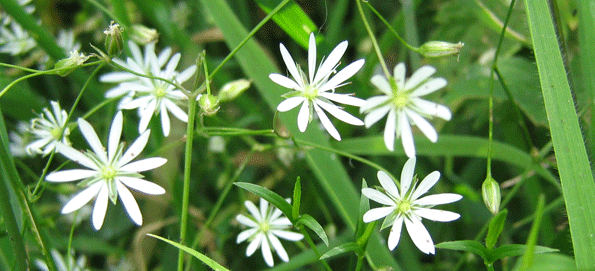
Wildlife in July
July is a great time to enjoy a walk round the park to admire the array of wild flowers that are in flower. The river banks, lake and path edges are becoming a mixture of colour as many of the plants come into flower; pink, purple, blue, yellow, white and even brown.
The tall spikes of dense pink flowers of purple loosestrife can be found around the banks of Moors Lake along with the cool blue flowers of meadow crane’s-bill form dense clusters above the foliage. Later, these develop into the long pointed pods that give the plant its name. Also look carefully for the tiny blue flowers of water speedwell.
The striking bright yellow and purple-veined flowers of the yellow iris open in June. This can be a useful plant for emerging dragonflies and damselflies as they make the transition from water to air.
Reedmace is a familiar water plant that is often, but incorrectly, known as bulrush. It can grow up to two and a half metres tall and has long thin leaves. The flowers, which can be seen in June and July, are brown sausage-shapes with straw coloured spikes coming out of the top. The seeds are dispersed by the wind, much like those of dandelions. A single flower can produce as many as 200,000 seeds.
Amongst patches of rough grass look out for tall stalks of bell shaped flowers from the familiar and poisonous foxglove and the larger white trumpet flowers of bindweed climbing its way around other plants and trees.
The pretty white flowers of greater stitchwort begin to flower in late March and will continue through to the end of June and sometimes well into July. They are commonly found around the rough grass verges of the pathways in the Park.
Flowers of birdsfoot trefoil can be found creeping through the grass. The bright yellow of the flowers is very attractive to insects and they will be pollinated by bees and butterflies which visit the flowers to collect their abundant nectar. The distinctive seed pods that look like birds feet and give the plant its name will appear later in the year after the flowers have been pollinated.
Bramble is also in flower attracting honey bees and hoverflies. There are over 300 microspecies of bramble and the flowers can range from white to light shades of pink.
Other things to look out for:
- The warm weather encourages the shy cold blooded reptiles to come out from cover and bask in the sunshine.
- Young water birds such as mallards, coots and moorhens may still be with their parents feeding themselves or like many other birds occasionally begging for food.
- The heathland plants are also alive with colour this month. All three species of heather will be showing their attractive purple flowers and the prickly gorse will be covered in yellow coconut smelling flowers.
- Bats can be seen at dusk flying around the lakes looking for emerging flies.







